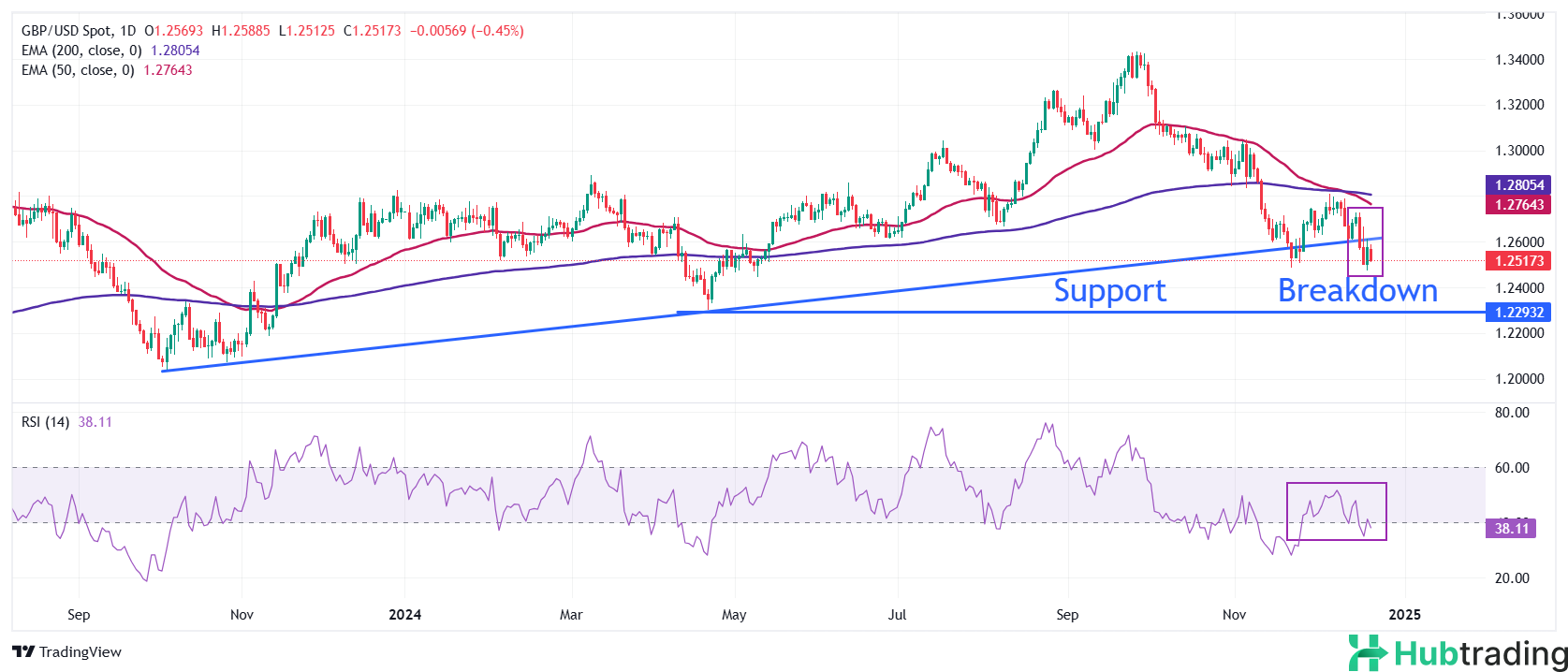- The Pound Sterling declines against the US Dollar as the Greenback rebounds, with Fed officials indicating fewer rate cuts in 2025.
- Recent comments from Fed officials reflect reduced willingness to cut rates in 2025 due to uncertainty around Trump’s policies.
- Revised UK GDP estimates for Q3 reveal that the economy remained flat.
The Pound Sterling (GBP) drops towards the psychological support level of 1.2500 against the US Dollar (USD) in Monday’s North American session. The GBP/USD pair sees a sharp decline as the US Dollar rebounds strongly after a sharp pullback on Friday. The US Dollar Index (DXY), which measures the Greenback’s value against six major currencies, recovers to around 108.10.
The US Dollar gains momentum as expectations for fewer rate cuts from the Federal Reserve next year grow. The latest dot plot shows only two rate cuts in 2025, down from four cuts projected in September. Market participants are also pricing in no rate change for the Fed’s January meeting, with the target range seen at 4.25%-4.50%, according to the CME FedWatch tool.
Fed officials’ comments highlight concerns over persistent inflation and stronger labor market conditions than anticipated, along with uncertainty regarding the economic impact of incoming Trump administration policies, leading to a more cautious stance on rate cuts for 2025. Cleveland Fed President Beth Hammack, the lone dissenter in the recent policy meeting, emphasized her preference for holding rates steady until further evidence of inflation’s return to the 2% target is seen.
With the holiday season leading to lower trading volumes, Forex markets could see more muted price action in the coming days. Meanwhile, US Durable Goods Orders data for November showed a decline of 1.1%, worse than the expected 0.4%, following a 0.3% increase in October.
Pound Sterling Weakens on Dovish Bank of England Bets
- The Pound Sterling falls against major currencies as market bets on a more dovish Bank of England (BoE) stance for 2025 rise. Traders now expect a 53-basis point (bps) rate cut next year, up from 46 bps following the BoE’s policy announcement on Thursday.
- Dovish sentiment grew after three out of nine Monetary Policy Committee (MPC) members advocated for a 25-bps rate reduction, exceeding market expectations. The 6-3 vote split is seen as a signal of a more dovish BoE, putting downward pressure on the Pound.
- Market expectations for a 53 bps cut suggest at least two 25-bps reductions in 2025. While BoE rate cut speculation aligns more with the Federal Reserve (Fed) than the European Central Bank (ECB), it positions the Pound as an attractive bet over the long term.
- Contrarily, Deutsche Bank analysts predict four rate cuts by the BoE in 2025, with one in the first half and three in the latter half of the year.
- On the economic front, Monday’s data revealed a downward revision of the UK’s third-quarter growth rate, raising concerns over the country’s economic outlook. The Office for National Statistics (ONS) reported zero growth in Q3, down from the 0.1% expansion previously estimated and a stark contrast to the 0.4% growth in Q2.
Technical Analysis: Pound Sterling Faces Further Decline Toward 1.2300

The Pound Sterling continues to weaken against the US Dollar following a decisive break below the upward-sloping trendline around 1.2600, which had been in place since the October 2023 low of 1.2035.
A death cross between the 50-day and 200-day Exponential Moving Averages (EMAs) near 1.2790 signals a strong long-term bearish trend.
The 14-day Relative Strength Index (RSI) has dropped below 40.00, indicating potential further downside momentum if the oscillator remains below this level.
On the downside, the pair may find support near the April 22 low around 1.2300, while resistance is seen at the December 17 high of 1.2730.





